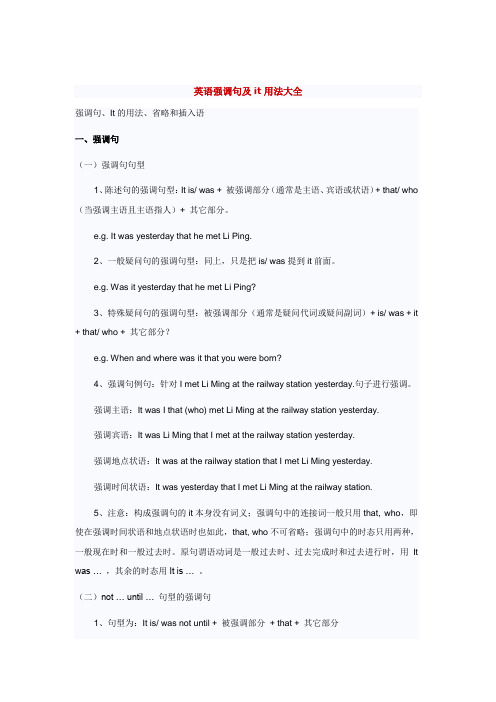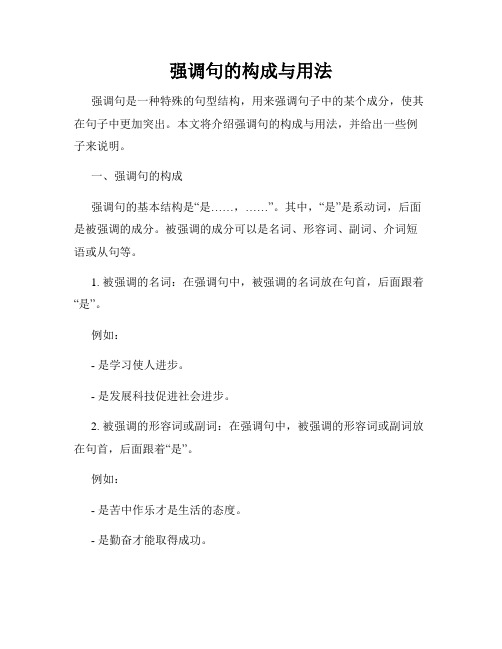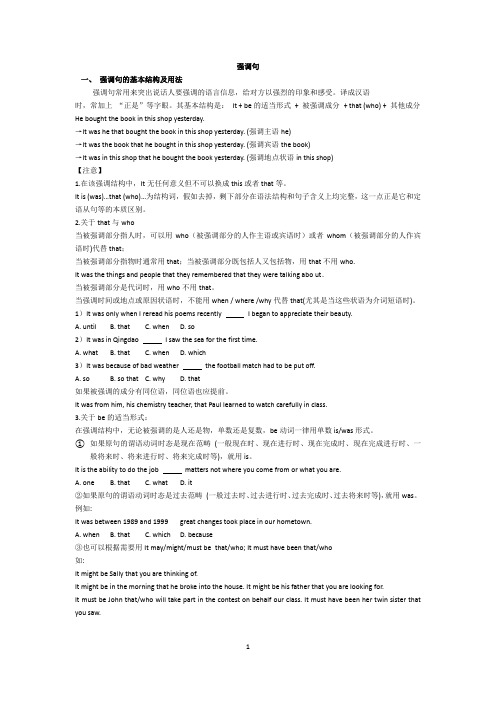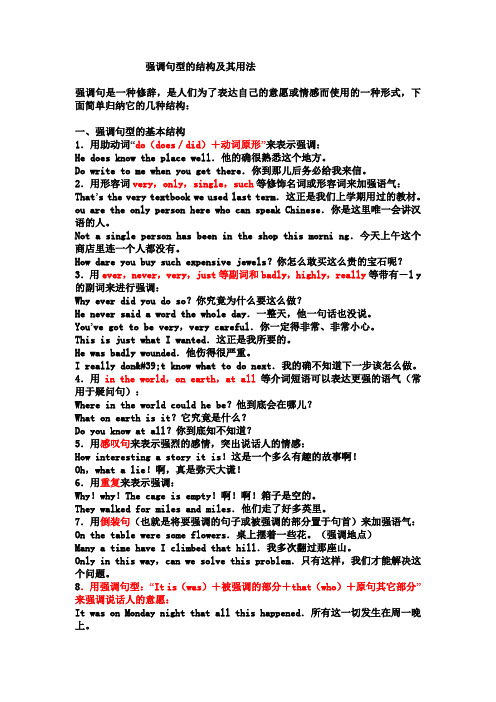(完整版)强调句型的结构及其用法
强调句型的结构及其用法

强调句型的结构及其用法强调句型是一种特殊的句式结构,用来强调句子中的一些成分或信息。
强调句型的基本结构是"It is/was + 被强调部分 + that/who + 强调语气动词"(一般强调句型),或"It is/was + 被强调部分 + that/who +主语 + 谓语"(特殊强调句型)。
一般强调句型的用法:1.强调主语:2.强调宾语:"It is the book that I borrowed from the library."(是这本书我从图书馆借来的。
)3.强调地点:"It was in Paris that I met my old friend."(是在巴黎我遇见了我的老朋友。
)4.强调时间:5.强调原因:"It is because of his hard work that he got promoted."(因为他的努力工作,他被晋升了。
)特殊强调句型的用法:1.强调主语动作:"It was John who ate all the cake."(是约翰吃掉了所有的蛋糕。
)2.强调主语状态:"It was Mary who was crying in the classroom."(是玛丽在教室里哭了。
)3.强调谓语动作:"It was at the party that I danced with him."(是在聚会上我和他跳舞了。
)4.强调谓语状态:"It was on the top of the mountain that I felt so alive."(是在山顶上我感到如此活力。
)强调句型的作用是使被强调部分更加突出,使句子更加生动、有力。
在口语和写作中都可以使用强调句型来加强语气和表达个人观点。
强调句的结构

强调句的结构强调句是一种常用的语法结构,用来突出某个句子成分或信息的重要性。
它通过在句子中使用特定的词语或结构来实现强调效果。
本文将介绍强调句的结构及其使用方法。
一、强调句的基本结构是"it is + 被强调部分 + that/who + 其他部分"。
例如:1. It is he who broke the window.(是他打破了窗户。
)2. It is the car that I've always wanted.(那辆车就是我一直想要的。
)3. It is in China that I met my lifelong friend.(我在中国遇到了我的终身朋友。
)以上的例子中,"it is"引导了强调句,"that/who"起到连接作用,并将被强调的部分放在其后。
可以看出,强调句的结构相对固定,但被强调的部分可以是主语、宾语、状语等。
二、强调句的使用方法1. 强调主语强调句可以通过强调主语来突出句子的主要动作或发出者。
例如:1. It is John who won the championship.(是约翰赢得了冠军。
)2. It is I who am responsible for the project.(是我负责这个项目。
)在上述例句中,通过强调主语"John"和"I",使得动作的执行者更加突出,给读者或听者留下深刻的印象。
2. 强调宾语强调句还可以通过强调宾语来使得句中的某个对象或行为更加显著。
例如:1. It is the book that I borrowed from the library.(就是那本我从图书馆借的书。
)2. It is his kindness that touched me.(正是他的善良打动了我。
)通过强调宾语"book"和"kindness",使得读者或听者对这些对象的重要性有更深刻的认识。
(完整版)英语强调句及it用法大全

英语强调句及it用法大全强调句、It的用法、省略和插入语一、强调句(一)强调句句型1、陈述句的强调句型:It is/ was + 被强调部分(通常是主语、宾语或状语)+ that/ who (当强调主语且主语指人)+ 其它部分。
e.g. It was yesterday that he met Li Ping.2、一般疑问句的强调句型:同上,只是把is/ was提到it前面。
e.g. Was it yesterday that he met Li Ping?3、特殊疑问句的强调句型:被强调部分(通常是疑问代词或疑问副词)+ is/ was + it + that/ who + 其它部分?e.g. When and where was it that you were born?4、强调句例句:针对I met Li Ming at the railway station yesterday.句子进行强调。
强调主语:It was I that (who) met Li Ming at the railway station yesterday.强调宾语:It was Li Ming that I met at the railway station yesterday.强调地点状语:It was at the railway station that I met Li Ming yesterday.强调时间状语:It was yesterday that I met Li Ming at the railway station.5、注意:构成强调句的it本身没有词义;强调句中的连接词一般只用that, who,即使在强调时间状语和地点状语时也如此,that, who不可省略;强调句中的时态只用两种,一般现在时和一般过去时。
原句谓语动词是一般过去时、过去完成时和过去进行时,用It was … ,其余的时态用It is … 。
强调句的构成与用法

强调句的构成与用法强调句是一种特殊的句型结构,用来强调句子中的某个成分,使其在句子中更加突出。
本文将介绍强调句的构成与用法,并给出一些例子来说明。
一、强调句的构成强调句的基本结构是“是……,……”。
其中,“是”是系动词,后面是被强调的成分。
被强调的成分可以是名词、形容词、副词、介词短语或从句等。
1. 被强调的名词:在强调句中,被强调的名词放在句首,后面跟着“是”。
例如:- 是学习使人进步。
- 是发展科技促进社会进步。
2. 被强调的形容词或副词:在强调句中,被强调的形容词或副词放在句首,后面跟着“是”。
例如:- 是苦中作乐才是生活的态度。
- 是勤奋才能取得成功。
3. 被强调的介词短语:在强调句中,被强调的介词短语放在句首,后面跟着“是”。
例如:- 是在良好的环境中学习才能更好地进步。
- 是在健康的身体中才能享受生活。
4. 被强调的从句:在强调句中,被强调的从句放在句首,后面跟着“是”。
例如:- 是你的努力才能决定成功与否。
- 是因为他犯了错误,才遭到了惩罚。
二、强调句的用法强调句通常用于以下几种情况:1. 强调句用于强调重要信息或特别突出的内容,以引起读者或听者的注意。
例如:- 是正确的道德观才能塑造一个良好的社会。
- 是少数几个人的违法行为影响了整个团队。
2. 强调句还可以用于表达对某个事实或观点的强烈肯定或否定。
例如:- 是他自己没有付出足够的努力。
- 是这本书对我产生了极大的影响。
3. 强调句也可用于对比两个事物或观点,突出它们之间的差异。
例如:- 是他工作努力才取得了成功,而不是凭借运气。
- 是现代科技给我们带来了很多便利,但也带来了许多问题。
总之,强调句在表达中起到了强调某种观点或事实的作用,使句子更加生动有力。
我们在写作时可以灵活运用强调句,以增强文章的表达效果。
此外,我们还要注意,强调句只适用于对某个句子中的成分进行强调,不适用于对整个句子进行强调。
另外,在使用强调句时,还需遵守语法和逻辑的要求,保持句子的完整性和连贯性,以确保文章的准确性和流畅性。
(完整版)高中英语强调句型专题讲解

强调句一、强调句的基本结构及用法强调句常用来突出说话人要强调的语言信息,给对方以强烈的印象和感受。
译成汉语时,常加上“正是”等字眼。
其基本结构是:It + be的适当形式+ 被强调成分+ that (who) + 其他成分He bought the book in this shop yesterday.→It was he that bought the book in this shop yesterday. (强调主语he)→It was the book that he bought in this shop yesterday. (强调宾语the book)→It was in this shop that he bought the book yesterday. (强调地点状语in this shop)【注意】1.在该强调结构中,It无任何意义但不可以换成this或者that等。
It is (was)…that (who)…为结构词,假如去掉,剩下部分在语法结构和句子含义上均完整,这一点正是它和定语从句等的本质区别。
2.关于that与who当被强调部分指人时,可以用who(被强调部分的人作主语或宾语时)或者whom(被强调部分的人作宾语时)代替that;当被强调部分指物时通常用that;当被强调部分既包括人又包括物,用that不用who.It was the things and people that they remembered that they were talking abo ut.当被强调部分是代词时,用who不用that。
当强调时间或地点或原因状语时,不能用when / where /why代替that(尤其是当这些状语为介词短语时)。
1)It was only when I reread his poems recently I began to appreciate their beauty.A. untilB. thatC. whenD. so2)It was in Qingdao I saw the sea for the first time.A. whatB. thatC. whenD. which3)It was because of bad weather the football match had to be put off.A. soB. so thatC. whyD. that如果被强调的成分有同位语,同位语也应提前。
强调句型的结构及其用法

强调句型的结构及其用法强调句是一种修辞,是人们为了表达自己的意愿或情感而使用的一种形式,下面简单归纳它的几种结构:一、强调句型的基本结构1.用助动词“do(does/did)+动词原形”来表示强调:He does know the place well.他的确很熟悉这个地方。
Do write to me when you get there.你到那儿后务必给我来信。
2.用形容词very,only,single,such等修饰名词或形容词来加强语气:That’s the very textbook we used last term.这正是我们上学期用过的教材。
ou are the only person here who can speak Chinese.你是这里唯一会讲汉语的人。
Not a single person has been in the shop this morni ng.今天上午这个商店里连一个人都没有。
How dare you buy such expensive jewels?你怎么敢买这么贵的宝石呢?3.用ever,never,very,just等副词和badly,highly,really等带有-l y 的副词来进行强调:Why ever did you do so?你究竟为什么要这么做?He never said a word the whole day.一整天,他一句话也没说。
You’ve got to be very,very careful.你一定得非常、非常小心。
This is just what I wanted.这正是我所要的。
He was badly wounded.他伤得很严重。
I really don't know what to do next.我的确不知道下一步该怎么做。
4.用in the world,on earth,at all等介词短语可以表达更强的语气(常用于疑问句):Where in the world could he be?他到底会在哪儿?What on earth is it?它究竟是什么?Do you know at all?你到底知不知道?5.用感叹句来表示强烈的感情,突出说话人的情感:How interesting a story it is!这是一个多么有趣的故事啊!Oh,what a lie!啊,真是弥天大谎!6.用重复来表示强调:Why!why!The cage is empty!啊!啊!箱子是空的。
强调句型的结构和用法
强调句型的结构和用法强调句型是英语语法中常用的一种结构形式,其作用是突出并强调某个句子成分的重要性或特殊性。
即通过语法上的手段,使特定的句子成分在语义上得到加重,以达到更好的表达和交流效果。
强调句型通常由“it is/was…that”这种结构引导,其基本形式是:It is/was+要强调的句子成分+that+主句。
例如:“It is the movie that I watched last night that I really enjoyed.”强调句型常用于口语和写作中,尤其是情感色彩较强的表达中,能够引起听者和读者的共鸣和体验,增强语言表达的感染力和说服力。
强调句型的用法包括以下几种:1.强调主语:It was Mary who passed the exam.是玛丽通过了考试。
2.强调宾语:It was the pizza that Jack ate for dinner.是杰克在晚餐时吃的那个比萨饼。
3.强调时间:It was yesterday that I met John.是昨天我遇见了约翰。
4.强调地点:It was in the park that I lost my phone.是我在公园里丢了手机。
5.强调原因:It was because of the heavy rain that the game was cancelled.是因为大雨比赛被取消了。
6.强调方式:It was in a loud voice that she answered the phone.是她用大声回答了电话。
强调句型不仅在日常交际和表达中应用广泛,而且在英语考试中也常被需要运用到。
因此,我们在学习英语的过程中,不仅需要掌握其基本形式和用法,还需要多做练习和实践,提高使用的熟练度和准确度。
强调句型归纳
强调句型归纳强调句型是英语语法中常用的一种句型结构,用于强调句子中的某个部分或者突出某个信息。
在写作中,正确运用强调句型可以使文章更加生动有力,增强表达的效果。
本文将对常见的强调句型进行归纳总结。
一、强调句型的基本结构强调句型的基本结构为"It is/was + 被强调部分 + that/who + 其他部分"。
其中,被强调部分可以是名词、形容词、副词、介词短语、动词短语等。
具体结构如下:1. It is + 被强调部分 + that + 句子的其他部分2. It was + 被强调部分 + that + 句子的其他部分二、强调句型的用法1. 强调名词强调句型可用于强调句子中的名词,使之成为句子中的重点。
例如:It is Mary who won the first prize in the competition.(重点强调Mary)It's the book on the table that I'm looking for.(重点强调book)2. 强调形容词强调句型可用于强调句子中的形容词,突出描述某个对象的特征。
例如:It is such a beautiful day that we decided to go hiking.(强调beautiful)It was the most difficult exam I have ever taken.(强调difficult)3. 强调副词强调句型可用于强调句子中的副词,加强对某个动作或状态的强调。
例如:It is always important to speak the truth.(强调always)It was only last night that I realized my mistake.(强调only)4. 强调介词短语强调句型可用于强调句子中的介词短语,使之成为句子中的重点。
例如:It is on the top of the mountain where we built our house.(强调on the top of the mountain)It was in the company of great writers that he found inspiration.(强调in the company of great writers)5. 强调动词短语强调句型可用于强调句子中的动词短语,突出某个动作或者事件的重要性。
强调句型的结构及其用法
强调句型的结构及其用法
1. 嘿,你知道吗?强调句型就是把要强调的部分凸显出来,就像在一群人中一下子把最重要的那个指出来一样!比如说“是他偷了我的钱包”,这里“他”就是被强调的。
2. 哎呀呀,强调句型有一种很直接的用法呢!就好比“我昨天就是在这里见到了他”,“昨天”和“这里”就是特别强调的呀,是不是一下子就突出重点啦?
3. 哇塞,强调句型还可以这么玩呀!像“是你,而不是别人,打破了花瓶”,用“是你”强调了是特定的你做了这件事。
4. 嘿嘿,强调句型在表达情感的时候也超好用呢!比如说“我真的非常非常喜欢你”,“真的”“非常非常”都起到了强调的作用。
5. 哇哦,想想看呀,“直到天黑他才回来”,这里“直到天黑”就是很重要的强调呀,让你一下子就明白回来的时间特殊。
6. 哎呀呀,强调句型的力量可大啦!就跟指明灯一样,比如“只有努力才能成功”,强调了努力对成功的重要性。
7. 嘿哟,“正是他帮了我大忙”,这里的“正是”就是强调呀,让你清楚知道是谁起到了关键作用。
8. 哈哈,强调句型的奇妙之处可多了去啦!“连小孩都知道这个道理”,强调了道理的浅显易懂嘛。
我的观点:强调句型就是用各种方式把要突出的部分鲜明地展示出来,让听的人或者读的人一下子能抓住重点,在表达中真的超级实用呀!。
强调句的构成和用法
强调句的构成和用法强调句是英语语法中常用的一种句型,用来强调句子中的某个成分或思想。
通过强调句的使用,可以使文章更加生动有力,突出重点,增强表达的效果。
本文将介绍强调句的构成和用法。
一、强调句的构成强调句主要由两个部分组成:强调词和被强调部分。
1. 强调词:通常位于句子的前面,用来强调句子的某个成分或思想。
常见的强调词包括:do, did, does, can, could, have, had, may, must, should, shall, will, would等。
2. 被强调部分:即需要强调的句子成分或思想。
二、强调句的用法强调句的使用可以增强语气,使表达更加有力,突出重点。
1. 强调句的基本结构强调句的基本结构为:"It is/was + 强调词 + 被强调部分"。
例如:- It is John who broke the window.(是约翰打破了窗户。
)- It was yesterday that I saw her.(是昨天我见到她的。
)2. 强调句的变换结构除了基本结构之外,强调句还可以通过变换结构来达到强调的效果。
a) 谓语动词的强调:将强调词放在助动词或情态动词之前。
例如:- I do love you.(我确实爱你。
)- He can swim.(他确实会游泳。
)b) 动词宾语的强调:将强调词放在动词宾语之前。
例如:- She saw him at the party.(她在聚会上见到了他。
)- It was him she saw at the party.(是她在聚会上看到了他。
)c) 主语的强调:将强调词放在句子的主语之前。
例如:- Mary is a doctor.(玛丽是一名医生。
)- It is Mary who is a doctor.(是玛丽是一名医生。
)d) 宾语的强调:将强调词放在句子的宾语之前。
例如:- We should finish the report.(我们应该完成这份报告。
- 1、下载文档前请自行甄别文档内容的完整性,平台不提供额外的编辑、内容补充、找答案等附加服务。
- 2、"仅部分预览"的文档,不可在线预览部分如存在完整性等问题,可反馈申请退款(可完整预览的文档不适用该条件!)。
- 3、如文档侵犯您的权益,请联系客服反馈,我们会尽快为您处理(人工客服工作时间:9:00-18:30)。
强调句型的结构及其用法
强调句是一种修辞,是人们为了表达自己的意愿或情感而使用的一种形式,下面简单归纳它的几种结构:
一、强调句型的基本结构
1.用助动词“do(does/did)+动词原形”来表示强调:
He does know the place well.他的确很熟悉这个地方。
Do write to me when you get there.你到那儿后务必给我来信。
2.用形容词very,only,single,such等修饰名词或形容词来加强语气:That’s the very textbook we used last term.这正是我们上学期用过的教材。
ou are the only person here who can speak Chinese.你是这里唯一会讲汉语的人。
Not a single person has been in the shop this morni ng.今天上午这个商店里连一个人都没有。
How dare you buy such expensive jewels?你怎么敢买这么贵的宝石呢?3.用ever,never,very,just等副词和badly,highly,really等带有-l y 的副词来进行强调:
Why ever did you do so?你究竟为什么要这么做?
He never said a word the whole day.一整天,他一句话也没说。
You’ve got to be very,very careful.你一定得非常、非常小心。
This is just what I wanted.这正是我所要的。
He was badly wounded.他伤得很严重。
I really don't know what to do next.我的确不知道下一步该怎么做。
4.用in the world,on earth,at all等介词短语可以表达更强的语气(常用于疑问句):
Where in the world could he be?他到底会在哪儿?
What on earth is it?它究竟是什么?
Do you know at all?你到底知不知道?
5.用感叹句来表示强烈的感情,突出说话人的情感:
How interesting a story it is!这是一个多么有趣的故事啊!
Oh,what a lie!啊,真是弥天大谎!
6.用重复来表示强调:
Why!why!The cage is empty!啊!啊!箱子是空的。
They walked for miles and miles.他们走了好多英里。
7.用倒装句(也就是将要强调的句子或被强调的部分置于句首)来加强语气:On the table were some flowers.桌上摆着一些花。
(强调地点)
Many a time have I climbed that hill.我多次翻过那座山。
Only in this way,can we solve this problem.只有这样,我们才能解决这个问题。
8.用强调句型:“It is(was)+被强调的部分+that(who)+原句其它部分”来强调说话人的意愿:
It was on Monday night that all this happened.所有这一切发生在周一晚上。
It’s me that he blamed.他怪的是我。
强调句型最重要的句型是: It is (was) +被强调部分+ that/ who +句子的其它成份。
英语中许多句子常常可以通过强调句型对句子的不同成份进行强调。
如:
They will have a meeting tomorrow.
It is they who /that will have a meeting tomorrow. (强调主语)
It is a meeting that they will have tomorrow. (强调宾语)
It is tomorrow that they will have a meeting. (强调时间状语)
应注意的要点:
1.强调句型可以用来强调主语、宾语(包括介词宾语)和状语。
其中的it 本身没有词义。
2.强调句中的连接词一般只用who(指人)或that(可指物,也可指人),若被强调的是状语,也只能用that ,而不能用when 或者where。
而且连接词都不能省略。
如: It was in the park that he met an old friend yesterday. (虽然强调的是地点,但不能用where。
)
3.强调句子的主语时,that 或who 之后的谓语动词的人称和数要与它前面被强调的名词或代词一致。
如:
It is Mary and Tom who often do good deeds.
4.强调句型的时态常见的有两种:一般现在时和一般过去时。
即It is ... that /who...和It was ...that/who...。
如:
It was the way he asked that really upset me.
5.判断一个句子是否是强调句的方法是:如果将句中的It is/was...that /who...去掉,经整理后还是一个完整的句子,本句就是强调句。
否则,就不是。
如:
It was in today’s newspaper that we found the news.去掉It was ...that 之后,句子可以整理为:We found the news in today’s newspaper.这是一个完整的句子,故本句是强调句。
常见考法:
1.用介词短语来作为被强调的部分。
如:
It was for this reason that he left that school.
It was in this way that he solved the problem.
2.用时间状语从句、条件状语从句等作为被强调的部分。
如:
It was only when I reread his poems that I began to appreciate their beauty.
3.用 not until 复杂结构作为被强调的部分。
如:
It was not until she took off her dark glasses that I realized she was a film star.
It was not until 1920 that regular radio broadcasts began.
4.在被强调的部分后接定语从句,使句子结构更加复杂。
如:
It was on July 7th 1975 when he was born that his father died.
5.通过句型转换来进行考查。
如把肯定句改成一般疑问句或特殊疑问句,或把
肯定句改成否定句或否定疑问句等。
如:
Was it during the Second World War that he died?
When was it that the sports meeting began?
It was not Tom that stole the book.
Wasn’t it he that had made a mistake?
6.通过改变系动词的形式来进行考查。
强调句型的系动词除了用 is 或 was 外,还可以在其前面加上 may / might /must 等表示推测的情态动词。
如:It might be him that you met yesterday.
真题:
1991
13. It was only _____ repaired by expert hands that its value and beauty revealed to the eye.
A. the unearthed pot was
B. that the unearthed pot was
C. when the unearthed pot was
D. the unearthed pot if。
